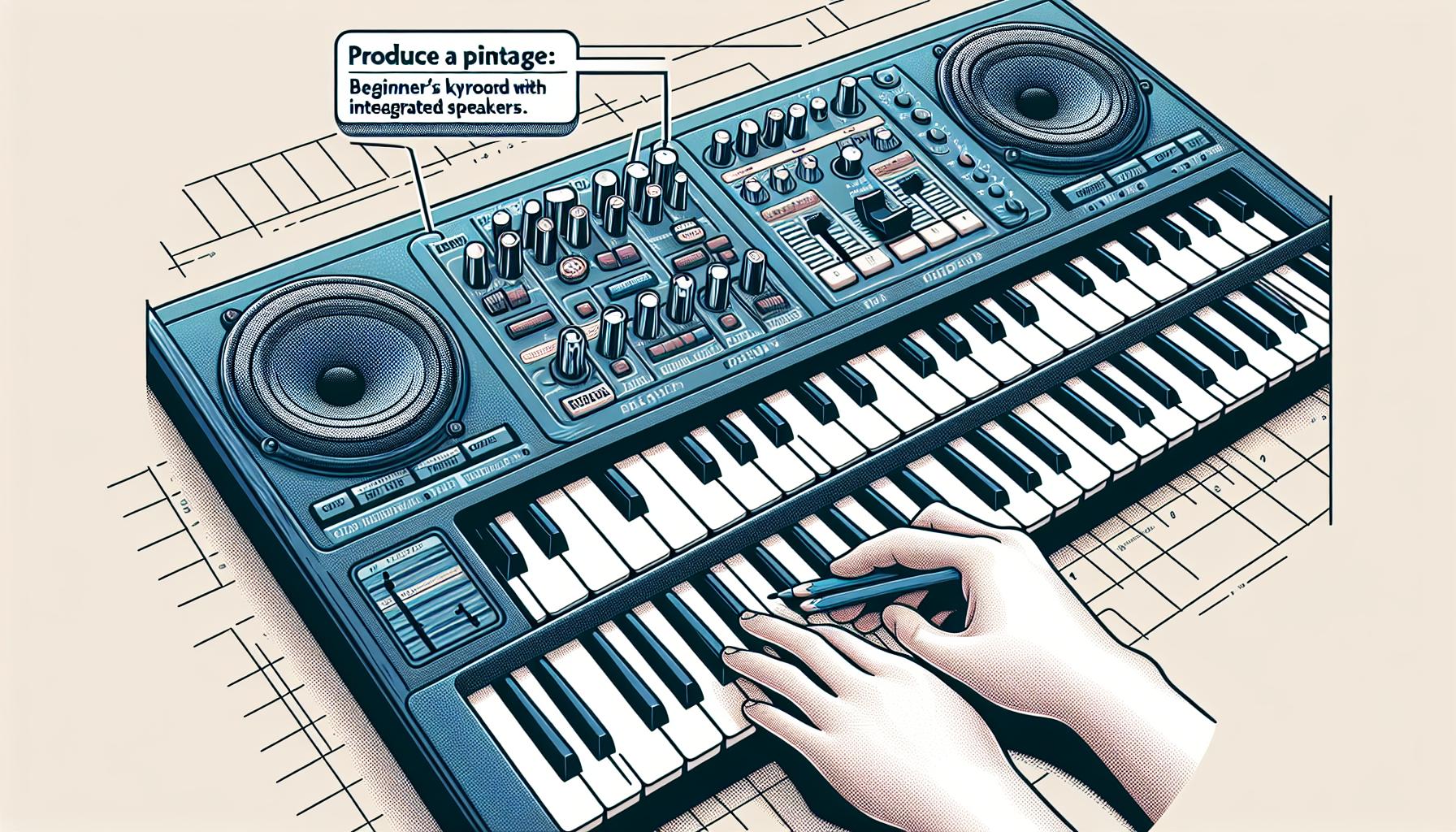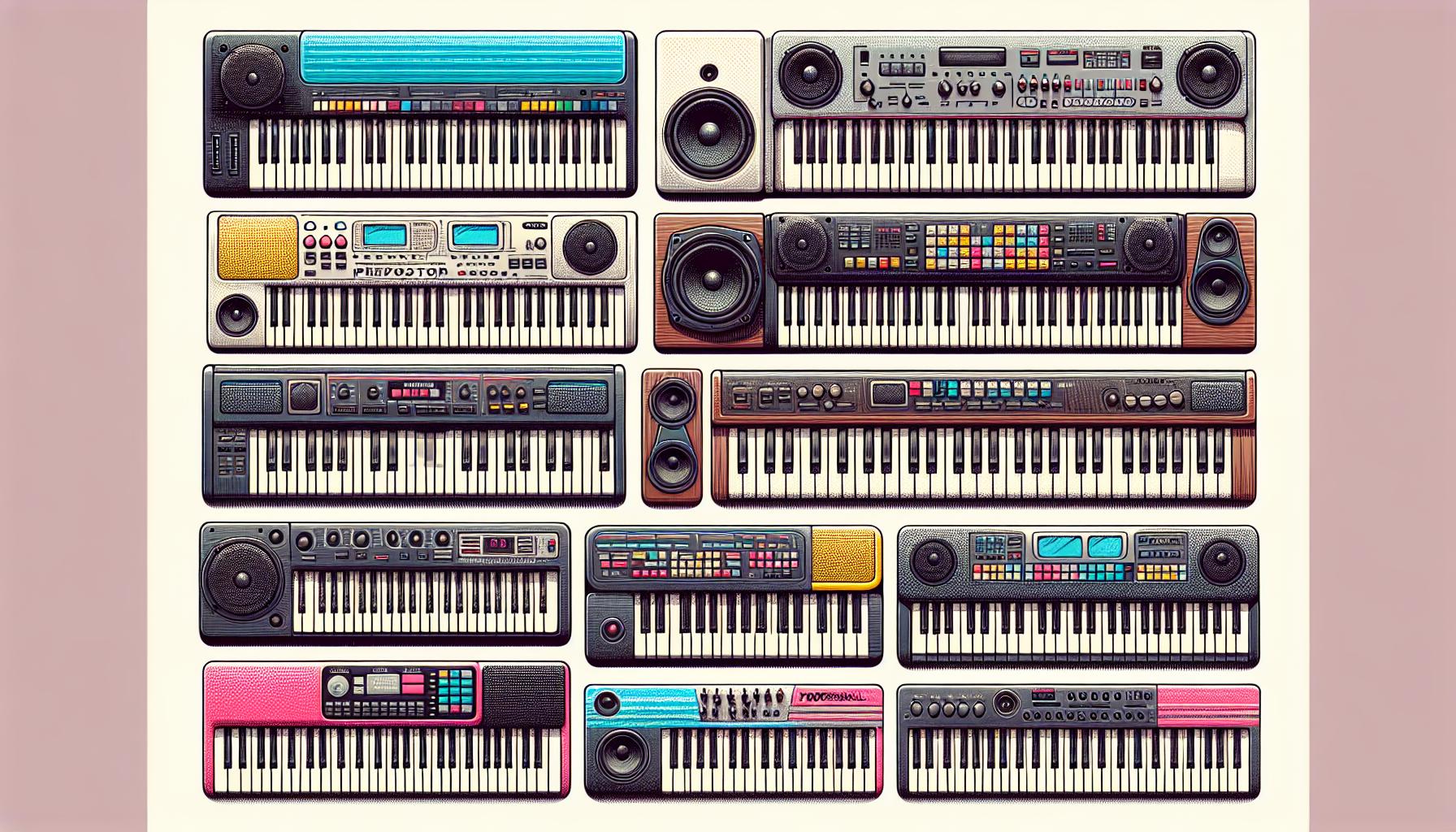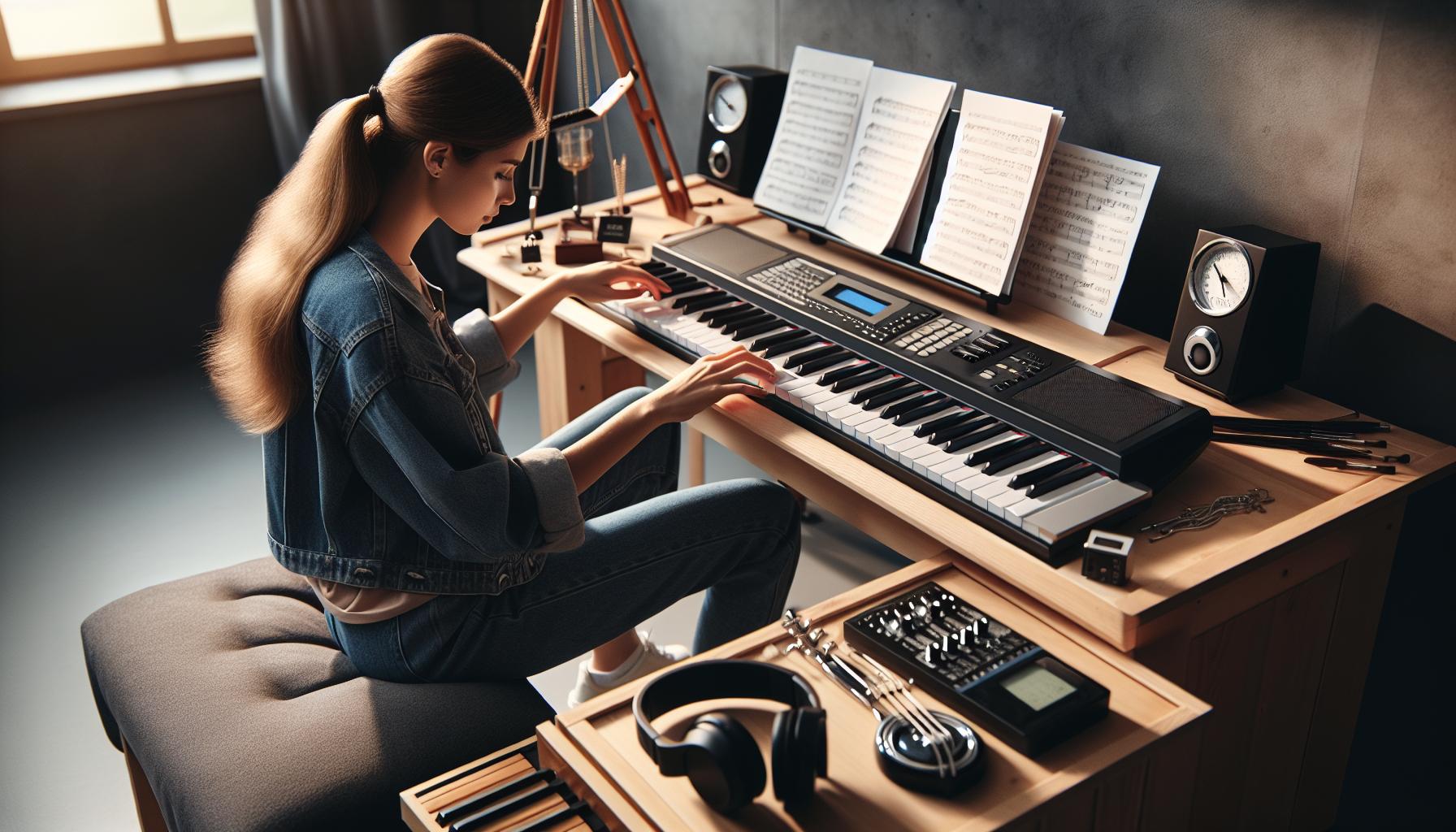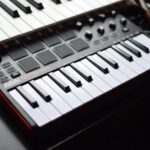Stepping into the world of music can be as thrilling as it is daunting, especially for those just beginning their journey. A beginner keyboard with built-in speakers offers a gateway into this world, combining convenience with the joy of creating music. It's the perfect starting point for anyone looking to tickle the ivories without the commitment of a grand piano.
These keyboards are not just about hitting the right notes; they're about exploration and fun. With a variety of sounds and rhythms at their fingertips, beginners can experiment and find their musical voice. It's an inviting first step that promises the thrill of music-making to novices and seasoned enthusiasts alike.
Benefits of a Beginner Keyboard with Built-in Speakers
When embarking on a musical journey, having the right equipment can make all the difference. Beginner keyboards with built-in speakers offer numerous advantages that can significantly enhance the learning experience. These instruments are designed with the novice in mind, blending functionality with ease of use to create an environment where creativity and exploration flourish.
One of the foremost benefits of opting for a keyboard with built-in speakers is the elimination of extra gear. Typically, playing an electronic keyboard requires an external amplifier or speakers to produce sound. However, with built-in speakers, learners can dive straight into practice without worrying about additional connections or equipment. This not only simplifies the setup process but also makes the keyboard highly portable. Learners can play anywhere, from their bedroom to a friend's house, without lugging around heavy equipment.
Moreover, these keyboards often come with a variety of pre-programmed sounds and rhythms, allowing beginners to experiment with different musical styles. Whether it's jazz, classical, or rock, learners can explore various genres at the touch of a button. This exposure is crucial in developing a broad musical palate and can inspire a deeper interest in music.
In addition to sounds, many beginner keyboards offer built-in learning tools. Features such as light-up keys, step-by-step lessons, and integration with music learning apps provide an interactive experience that can accelerate the learning process. For those who prefer self-teaching, these tools can be invaluable, offering guidance and feedback without the need for a personal tutor.
| Feature | Benefit |
|---|---|
| Built-in Speakers | Eliminates the need for external equipment |
| Variety of Sounds | Encourages exploration of different musical styles |
| Learning Tools | Facilitates self-teaching and speeds up learning |
Financially, these keyboards represent a cost-effective entry point into the world of music. Investing in a full-sized piano or a high-end keyboard can be quite expensive, especially for beginners who are still gauging their interest in music. A beginner keyboard with built-in speakers provides the essential features needed to start playing at a fraction of the cost. This makes starting a musical hobby more attainable and less daunting.
Features to Look for in a Beginner Keyboard

When venturing into the world of musical exploration, selecting the right beginner keyboard can be pivotal. Among a myriad of options, certain features stand out for their ability to enhance the learning experience. Understanding these can make the decision process smoother and ensure that budding musicians have everything they need to start on the right note.
Built-In Speakers are at the top of the list. They remove the hassle of external attachments, making it easy for learners to practice anytime, anywhere. The quality of these speakers varies, so it's worth looking for keyboards that offer clear and loud enough sound for a fulfilling practice session.
Touch Sensitive Keys present another critical feature. They respond to the pressure applied, mimicking the dynamics of an acoustic piano. This responsiveness is crucial for developing expressive playing and understanding the subtleties of soft and loud playing.
A Wide Range of Sounds and Rhythms allows learners to explore different musical genres, from classical to pop, jazz to electronic. This variety not only keeps practice sessions engaging but also introduces learners to the vast world of music, aiding in the development of a well-rounded musical taste.
An often-overlooked feature is the Integration of Learning Tools. Keyboards that come with light-up keys, built-in lessons, or apps can accelerate the learning process. They offer a visual aid and step-by-step guidance that can be especially beneficial for self-taught musicians.
| Feature | Benefit |
|---|---|
| Built-In Speakers | Eliminates need for external gear, enhances portability |
| Touch Sensitive Keys | Mimics acoustic piano, develops expressive playing |
| Varied Sounds/Rhythms | Encourages exploration of genres, broadens musical scope |
| Learning Tools | Facilitates self-teaching, accelerates learning curve |
Connectivity options such as USB/MIDI ports might not seem crucial at first glance, but they offer significant advantages. They allow the keyboard to connect to computers and mobile devices, opening up a world of digital learning resources and recording possibilities. This feature ensures that as learners advance, their keyboard can still serve as a valuable tool, bridging the gap between beginner and intermediate levels.
Top Beginner Keyboard Models with Built-in Speakers

When stepping into the world of music, having the right instrument can make all the difference. For beginners, keyboards with built-in speakers offer the convenience of portability and the immediacy of sound without needing extra equipment. Here are some top models that strike the perfect harmony between quality, features, and price.
Yamaha PSR-E273
Known for its rich features and excellent sound quality, the Yamaha PSR-E273 is an ideal choice for novices. It boasts a wide array of 400 voices and 130 styles, making it incredibly versatile for its price point. The Quiz Mode turns learning into an engaging game, enhancing the beginners' experience. Moreover, it’s equipped with Yamaha's own Ultra-Wide Stereo technology, ensuring a grand sound from its modestly sized built-in speakers.
Casio CT-S300
Casio's CT-S300 stands out for its touch-sensitive keys, a crucial feature for those aspiring to play the piano seriously. It’s particularly friendly for beginners with its dance music mode that allows users to create and remix electronic dance music effortlessly. The built-in carry handle, lightweight design, and strap pins for playing on the go highlight its ultimate portability.
Alesis Recital 61
The Alesis Recital 61 offers 61 full-sized keys and is powered by Alesis's acclaimed sound engine, featuring 10 premium voices. What makes it unique is its 20W built-in speakers, delivering a powerful sound that is uncommon in keyboards aimed at beginners. Additionally, its Lesson Mode divides the keyboard into two areas with the same pitch and voice, facilitating instructor-student or parent-child learning.
RockJam RJ761
The RockJam RJ761 is a complete package for those starting their musical journey. It includes a keyboard stand, stool, and sustain pedal, making it ready to use right out of the box. The RJ761 features 200 rhythms and 50 demo songs, plus it comes with a month's free membership to JoyTunes’ Simply Piano app. This coupling of physical and digital learning resources can significantly boost a beginner's progress.
| Model | Key Features | Voices | Rhythms | Special Features |
|---|---|---|---|---|
| Yamaha PSR-E273 | Ultra-Wide Stereo, Quiz Mode | 400 | 130 | Game-like Learning |
Tips for Getting Started with a Beginner Keyboard

Venturing into the world of music through a keyboard is an exciting journey. To make the most out of this experience, beginners should consider several practical tips that can significantly enhance their learning curve.
First and foremost, setting a regular practice schedule is key. Just like any new skill, consistency is crucial. Ideally, they should aim for at least 20 to 30 minutes of practice per day. This doesn't have to be a daunting task. Breaking it into shorter, manageable sessions can make practice feel less overwhelming and more enjoyable.
Secondly, beginners should explore the different voices and rhythms their keyboard offers. Most beginner keyboards come with an array of pre-set sounds and backing tracks. Experimenting with these can not only be fun but also inspirational, allowing learners to discover various musical styles and sounds. This exploration can also spark creativity and a deeper understanding of music composition.
Another helpful practice is to utilize online resources and apps. There's a wealth of free and paid tutorials, lesson plans, and interactive games designed to complement physical practice. These resources are not just supplementary; for many beginners, they're a crucial part of their learning, offering visual and auditory guidance that can accelerate the understanding of music theory and technique.
For learners who prefer a structured approach, considering a teacher or a music course might be beneficial. A good teacher can provide personalized feedback, help set realistic goals, and address specific areas of improvement. While self-teaching is entirely possible, guided instruction can often lead to faster progress and a more solid foundation.
Lastly, beginners shouldn't overlook the importance of having the right accessories. A sturdy stand, a comfortable bench, and quality headphones can make practice sessions more comfortable and productive. Additionally, investing in a metronome, either digital or mechanical, can greatly help with rhythm training and tempo control.
Diving into keyboarding with a clear plan and the right resources can make the learning process both effective and delightful. Beginners should embrace the journey, celebrate small victories, and remain patient and persistent in their practice.
Conclusion
Embarking on the journey of learning to play the keyboard is both exciting and rewarding. With the right approach and tools, beginners can make significant strides in their musical education. Remember, the key to mastering any instrument lies in dedication and the willingness to explore and experiment. By following the tips outlined, learners are well-equipped to navigate the early stages of their musical journey. Let's embrace the adventure with enthusiasm, knowing that every practice session brings us one step closer to our goals. Happy playing!
Harlan Kilstein began playing piano during covid with no piano background at all. He taught himself how to play learning what to do and what not to do.
Today he's an advanced intermediate player and can help you grow in your skills because he learned all this on his own.








